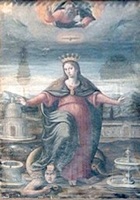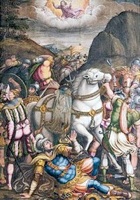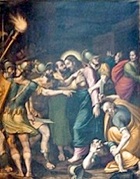

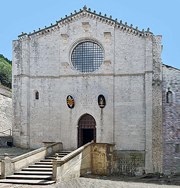
Old Duomo of San Mariano
The early chronicles of Gubbio record a circuit of walls that existed from at least 921. Paolo Micalizzi (referenced in the page on the city gates of Gubbio) has deduced that these walls enclosed only a small area around the present site of San Giovanni Battista. A document of 1096 specifies that the enclosed complex included the first Duomo of San Mariano, the Canonica and an associated hospice. ( It seems likely that it also included the “plebem ... S. Johannis de civitate” (parish church of St John), which was was documented as a possession of the canons of San Mariano in 1137, 1143, 1170 and 1182).
Note that an early Christian inscription (4th or 5th century) in the Sacristy (see below), which was found in 1785 near San Giovanni Battista, records that the Archdeacon Aemilianus had been responsible for the construction of the ‘basilica sanctorum apostolorum’, which could have related to tho original dedication of this Duomo as Santi Apostoli. This old Duomo almost certainly contained the relics of SS Marianus and James, which had probably been translated to Gubbio by Christians fleeing the Vandal invasion of Africa in ca. 500, and we might reasonably assume that its dedication was changed at this point. In ca. 1040, when Bishop Theobald I (1032-57) formed a community of canons to administer it.
SS John of Lodi and Ubaldus
The uncle who cared for the orphaned St Ubaldus belonged to the canonical community of San Mariano in the late 11th century. The young St Ubaldus spent part of his school days here, but he soon left because he disapproved of the way of life of the canons. When St John of Lodi, the erstwhile Prior of the Eremo di Fonte Avellana, began the reform of this community during his short period as bishop of Gubbio in 1105, he persuaded St Ubaldus to return to San Mariano.
St Ubaldus was ordained in 1115 and was elected Prior of the Cannonica of San Mariano in 1118. He was sympathetic to the cause of Church reform and imposed what is known as the Portuense Rule on the community. (Pope Paschal II had confirmed this rule in 1116 for a community of regular canons at the church of Santa Maria in Portu on the island of Corizo near Ravenna, and it subsequently became widely diffused in Italy, France, Spain and Germany.)
The old Duomo seems to have been restored to some extent after the fire: for example, a donation is recorded in 1141 for this purpose. When St Ubaldus died in 1160, he was buried there, beside the relics of SS Marianus and James.
Present Church
Benedetto Bentivoglio, a canon of the Duomo of Perugia, had become bishop of Gubbio in 1184, perhaps as a consequence of Gubbio’s submission to Perugia in the previous year. He seems to have been the prime mover in the development of a new ecclesiastical complex on the lower slopes of Monte Ingino:
-
✴In 1188, Pope Clement III gave him permission to translate the relics of the saints of Gubbio (presumably those of SS Marianus and James as well as those of St Rudolf Gabrielli - see below - and the body of the future St Ubaldus) from the “antiqua civitate” to the site on the mountain, where the “civitas de novo” had been constructed.
-
✴Shortly thereafter, Bishop Bentivoglio conceded to the canons a new site for their palace “in quo constructum est” (on which was constructed) the new Duomo of SS Mariano e Ubaldo and the episcopal palace.
The diploma (1191) in which the Emperor Henry VI granted important privileges to Gubbio also gave retrospective permission for the construction of the “novam civitatem” on Monte Ingino. The development must have been largely complete by 1203, when a document was agreed “ante ecclesiam ... in platea ubi fit contio” (in front of the cathedral ... in the square in which meetings are held). It is clear that, at least by that time, the new city housed to civic as well as the ecclesiastical authorities: another document of 1203 was notarised “sub tracandam palatii communis Eugubini” ( under the covered loggia of Palazzo Comunale of Gubbio) and traces of this palace survive under what is now Palazzo Ducale. The new Duomo and Palazzo Comunale opened onto the “platea communis”, which was bounded by the new city wall and a city gate, Porta di Santa Agnese.
In 1194, two years after the canonisation of St Ubaldus, his relics were translated to an oratory at the summit of Monte Ingino, which was near a church that was dedicated to the Milanese SS Gervasio and Protasio. (This was later to become the site of Basilica di Sant’ Ubaldo). It is likely that this site was chosen so that the soldiers stationed at the nearby Rocca Posteriore could protect the relics.
Bishop Pietro Gabrielli (1326-45) built the current façade. Bishop Giovanni da Morlacca (1350-70) re-consecrated the high altar in 1366, probably after a major remodelling or restoration. Bishop Federico Fregoso (1508-41) renewed the floor of the Duomo, raising it to overcome the problem of damp. A now-lost inscription on the facade recorded a further restoration by Bishop Marcello Corvino (1544-55), who reigned as Pope Marcellus II for a few months before his death in 1555. Bishop Alessandro Sperelli reconsecrated the Duomo in 1652,
The interior was transformed in the Baroque style in ca. 167, but was returned to something like its original form in 1913-18.
Exterior
A flight of steps leads to the ogival entrance in the main façade. [The remains of the 12th century church are visible on the right of the facade.]
The symbols of the four Evangelists and the Lamb of God that surround the rose window above probably came from the previous church. (There is a fine view of them from the internal loggia of the Palazzo Ducale opposite).
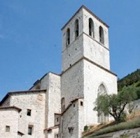
Interior
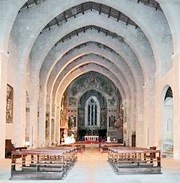
The interior, which has a single nave with ten rhythmic arches, is typical of the churches of Gubbio.
Traces of the 16th century pavement survive in the presbytery and the lateral chapels, and near the floor tomb of the Bishop Fregoso (see below) in the centre of the nave.
Bishop Marcello Corvino (1544-55), who reigned as Pope Marcellus II for a few months before his death in 1555, re-modelled the church in 1549-50, in the light of the new religious ethos emerging from the Council of Trent.
Relics of Saints
The relics of SS Marianus and James , which were translated to the new Duomo in 1188, are preserved in a late Roman sarcophagus under the high altar (below). Those of St Rudolf Gabrielli, a monk from the Eremo di Fonte Avellana, were also translated at this time, but they were lost during the remodelling of ca. 1670.
The Duomo also preserves the relics of a number of other saints :
-
✴St Forte Gabrielli, a monk from the Eremo di Fonte Avellana, under the 6th altar on the left;
-
✴Blessed Villanus, Bishop of Gubbio (1206-40), under the 7th altar on the left; and
-
✴St Virginia (a virgin martyred in Rome), under the 9th altar on the left.
In 1648, Bishop Alessandro Sperelli arranged for the relics of St John of Lodi to be translated to the altar in the 8th bay on the left, having re-robed the saint's body and placed his own episcopal ring on its finger.
Episcopal Monuments
A number of monuments to bishops of Gubbio (in addition to those of the Blessed Villanus - above) survive in the Duomo:
-
✴Pietro Gabrielli (died 1345), high up on the counter-façade, to the right of the entrance;
-
✴Gabrielle Gabrielli (died 1383), to the right on the counter-façade, partly obscured by the wooden screen around the portal;
-
✴Federico Fregoso (died 1541), in the pavement of the nave; and
-
✴Alessandro Sperelli (died 1672), in the Cappella del Santissimo Sacramento (see below).
Presbytery
The original arch of the presbytery was removed as part of the remodelling of 1544-55, in order to improve the visibility of the high altar from the nave.
The whereabouts of this organ are unknown, although the associated choir survives in situ.
The frescoes of the presbytery (below), its stained glass and the high altar all date to the early 20th century restoration.
Crucifix (13th century)
This wooden Crucifix stands behind the high altar.
Wooden Furnishing (1548-51)
In 1548-51, Giacomo and Girolamo Maffei received payments for:
-
✴the choir stalls;
-
✴the bishop's throne, which bears the arms of Bishop Giacomo Savelli (1555-61); and
-
✴the organ casing and associated choir (below).
Organs and Casings
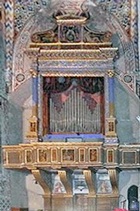
-
✴As noted above, Giacomo and Girolamo Maffei received payments for the organ casing and associated choir in 1548-51.
-
✴Pietro Paolo Baldinacci and Benedetto Nucci are documented in relation to its painted panels (ca. 1549). These are probably:
-
• those in the cimasa, which depict the arms of Bishop Marcello Corvino and two reclining angels; and
-
•those at the bases of the columns to the sides of the organ, each of which depicts a personification of a Virtue.
The organ by Lesichius no longer survives: Bishop Vincenzo Massi commissioned the present organ from Angelo Morettini in 1833.
The arms of Bishop Massi and an associated inscription appear on the organ casing on the left, which might have been built as a replica of that on the right in 1833. It is possible that the organ by Lesichius was moved here at that point. Unfortunately, the organ was later destroyed (probably during the Second World War) and the space in which it had been installed is now blank.
Choirs under the Organ Casings
Canon Alessandro Zeccadoro commissioned from “mastro Perino” seven sculpted figures personifying the Liberal Arts for the organ casing. These figures no longer survive. However, they seem to be depicted in the choir under the casing on the right (by Giacomo and Girolamo Maffei) in the fresco (1654-8) of Bishop Sperelli’s consecration of the Cappella del Santissimo Sacramento, which is in the lunette on the left wall of that chapel (see below).
-
✴If this hypothesis is correct, the present painted panels in the right choir must have been reused from another location.
-
✴Similarly, if (as suggested above) the choir on the left is a 19th century replica of that on the right, its painted panels must have been similarly reused.
The present panels (16th century) in both choirs are attributed to Benedetto Nucci.
Seats of the Magistrates (ca. 1555)
These seats (under the organ on the left) might well have been begun as part of the work for which Giacomo and Girolamo Maffei were paid 0n 1548-51. However, they bear the arms of Bishop Giacomo Savelli (1555-61), which suggests that they were completed soon after 1555. They contain fictive intarsia panels (1557) that are signed by Benedetto Nucci and dated by inscription (on the 7th seat on the right).
Frescoes (1916-8)
These frescoes on the walls of the presbytery are by Augusto Stoppolini.
Nave
Frescoes (14th century)
The walls of the nave were originally covered with frescoes, the surviving traces of which depict:
-
✴figures of saints, including St Christopher (2nd bay on the left);
-
✴frescoes [subject??] (2nd bay on the right);
-
✴the Madonna and Child with SS James and Marianus (9th bay on the right)
-
✴frescoes (9th bay on the left) including
-
•a figure of St Agatha and the scene of her martyrdom;
-
•the Madonna and Child; and
-
•a bishop saint (possibly St Ubaldus); and
-
✴St Christopher (on the pilaster of the 7th bay on the right).
The remains of a fresco (15th century) of Christus Patiens can be seen above the altarpiece in the 1st bay on the left.
Immaculate Conception (1584)
St Bartholomew (1572)
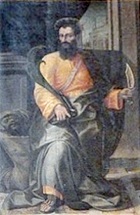
Pietà (after 1560)
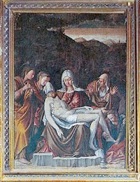
Incredulity of St Thomas (1587)
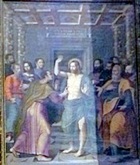
Way to Calvary (1564)
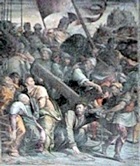
Madonna and Child with saints (1570)
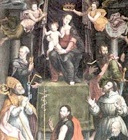
St Ubaldus (ca. 1590)
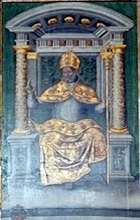
Madonna and Child with SS Sebastian and Ubaldus (1507)
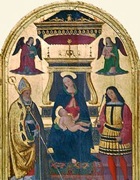
Scenes from the life of St John of Lodi (ca. 1900)
These frescoes by Augusto Stoppoloni in the 8th bay on the left (the site of the relics of St John of Lodi) depict two scenes from his life:
-
✴his journey to Puglia during the famine of 1085 in order to obtain grain for the poor of Gubbio; and
-
✴his welcome of the young St Ubaldus in 1204 to San Mariano, after his election as Bishop of Gubbio.
St Mary Magdalene (ca. 1526-9)
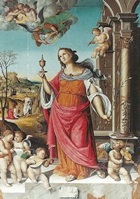
In the altarpiece, St Mary Magdalene holds a lily and a chalice that contains the ointment with which she massaged the feet of Christ. An angel descends to crown her, and a series of musical putti witness the scene. The “Noli me tangere” (the encounter with the risen Christ) takes place in the background.
Adoration of the Shepherd (ca. 1521)
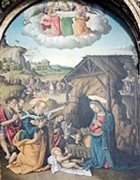
Conversion of St Paul (1596)
Resurrection (1588)
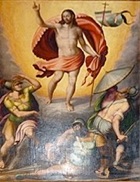
Capture of Jesus (1575)
Annunciation (ca. 1600)
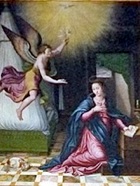
Cappella del Santissimo Sacramento
In 1651, Bishop Alessandro Sperelli began the construction of the Cappella del Santissimo Sacramento (off the right wall) in honour of the Virgin of Loreto. This chapel, which is in the form of a Greek cross, extends on a terrace from the right side of the Duomo. It is the only surviving element of the Baroque decoration of the Duomo in the 17th century.
[The relics of the Blessed Gennara were moved from Santo Spirito to this chapel at some point after 1856.]
The funerary monument of Bishop Alessandro Sperelli (died 1672), whichwas originally at the centre of the nave, was moved to this chapel in 1917.
Frescoes (1652-4)
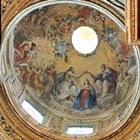
-
✴the Coronation of the Virgin, in the cupola, illustrated here;
-
✴the bishop saints of Gubbio (SS Ubaldus, Peter Damian, Rodolfus and John of Lodi), in the pendentives;
-
✴SS Marianus and James, to the sides;
-
✴two scenes on the back wall;
-
•the transport of the house of the Virgin to Loreto; and
-
•the Annunciation;
-
✴Bishop Sperelli’s consecration of the church, in the lunette on the left wall, with an interesting representation of the church at that time; and
-
✴the translation of the relics of St John of Lodi, in the lunette on the right wall.
Birth of the Virgin (1684)
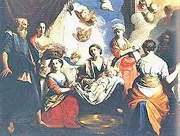
The original inscription on this panel on the left wall, which is no longer visible, named the artist, Antonio Gherardi and gave the date.
Crypt
A door in the right wall leads down to the crypt. The remains of some of the bishops of Gubbio are preserved under the altar (12th century). An entrance at the foot of the stairs that lead down to the crypt opens into the Museo Diocesano.
Crucifixion (ca. 1300)
This fresco is on the wall of the stairs.
Panel (19th century)
This panel on the wall of the stairs, which is attributed to Camilla Filicchi, depicts the patron saints of Gubbio entrusting the city to the protection of the Virgin.
Sacristy
[Where is it ??]
Early Christian Inscription (4th - 5th century)
Gianfranco Binazzi (referenced below, at pp. 165-7, entry 107) published and illustrated this inscription, which is now apparently in the sacristy. It was discovered in 1785 near the church of San Giovanni Battista. It is on a now-fragmentary marble slab, below a depiction of the Chi-Rho christogram flanked by the Greek letters alpha and omega, within an oval, flanked by two birds (only one of which survives) with branches in their beaks. The surviving part of the inscription reads:
Aelianus Arcediaco .., ...nus ad fabricam b[asil]icae sanctor[um] [apos]tolorum
This probably records that the archdeacon Aelianus had been responsible for the construction of a church dedicates as SS Apostoli (perhaps the first Duomo).
Art from the Duomo
SS Marianus and James (late 13th century)
These originally polychrome marble statues of the saints dressed as deacons, which probably came from the Duomo, are now in the Museo Diocesano.
Reliquary (1369)
This reliquary was made to house a relic of a finger of St John the Baptist that was moved to the Duomo from San Giovanni Battista at an unknown time after 1263. It was apparently signed by Andreas Stafilio da Norcia and dated by inscription. It was documented in the sacristy of the Duomo in 1885, but replaced in 1913 by another that is now in San Giovanni Battista.
The fate of the 14th century reliquary is unknown. It is however represented in a panel (1830) by Camilla Filicchi in the baptistery of San Giovanni Battista, which depicts St Ubaldus standing beside an altar on which the reliquary stands.
Cope (15th century)
According to tradition, Pope Marcellus II, who had been Bishop of Gubbio, gave Flemish brocade cope to the Duomo in 1555, the year of his papacy and of his death. However, it was probably made locally at an earlier date, using designs by a follower of Joos van Wassenhove (Justus of Ghent), a Flemish artist who was active at the court of Duke Federico da Montefeltro in the 1470s. It is now in the Museo Diocesano.
The cope was originally decorated with seven embroidered panels depicting scenes from the Passion of Christ:
-
✴Christ before Pilate*;
-
✴Christ in the Garden of Gethsemane*;
-
✴the kiss of Judas*;
-
✴the Flagellation,
-
✴the crown of thorns;
-
✴the road to Calvary; and
-
✴the Communion of the Apostles (on the hood).
Unfortunately, the three panels marked with an asterisk above were stolen in 1993.
Universal Judgement (1569)
This altarpiece, which is signed by Virgilio Nucci and dated by inscription, is the earliest securely dated work by this artist. It came from the Duomo and is now in the deposit of the Pinacoteca Civica.
Baptism of Christ (16th century)
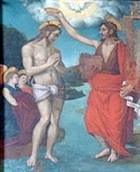
Blessed Villanus (17th century)
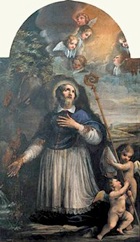
Read more:
G. Binazzi, “Inscriptiones Christianae Italiae: Regio VI; Umbria”, (1989) Bari
Return to Monuments of Gubbio.
Return to Walk I.
